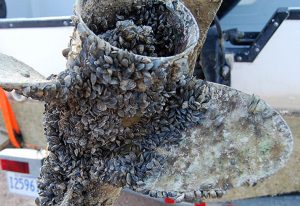
From the official press release . . .
On April 15, Montana’s full response to the invasive mussels begins statewide with more than 30 inspection stations, decontamination stations for boats leaving Tiber and Canyon Ferry Reservoirs and a broad outreach and education effort to help ensure people recreating on Montana’s waterways are practicing clean, drain and dry techniques at all times.
The biggest changes will be seen by those recreationists at Tiber and Canyon Ferry. In March, the Montana Fish and Wildlife Commission approved rules requiring boaters on Canyon Ferry and Tiber reservoirs to launch and exit at designated boat ramps, unless they are officially certified as local boaters on those specific waters by Montana Fish, Wildlife and Parks.
While local boaters won’t be required to decontaminate their vessels with hot water each time they leave Tiber or Canyon Ferry – they’ll still be required to stop at an inspection station where they’ll be expedited through after a brief interview. The program is designed to decrease volume at decontamination stations and allow a focus on boats traveling elsewhere.
The local boater program will allow watercraft owners to complete educational training on aquatic invasive species and sign an agreement with FWP pledging to only use the boat at either Tiber or Canyon Ferry reservoir. This training is available online at musselresponse.mt.gov.
At Tiber and Canyon Ferry boat ramps will be designated as open either to all boats or certified local boaters only. Currently, two boat ramps at each reservoir are open for all boaters. At Canyon Ferry, these boat ramps are the Silos on the southwest side of the lake and Shannon on the north end near the dam. At Tiber, the Tiber Marina and VFW ramps, both near the dam, are open to all boaters. Other boat ramps on each reservoir are open to certified local boaters only.
On both reservoirs, local boater ramps will be clearly marked. Maps for each reservoir are also available online at musselresponse.mt.gov.
Watercraft inspection stations will be operating around Montana starting April 15, with specific attention given to inspecting watercraft that may be coming into Montana from out of state or cross the Continental Divide into the Columbia River Basin. People traveling with watercraft, both motorized and nonmotorized – including canoes, paddleboards and kayaks – must stop when they encounter an inspection station.
Key points to remember are:
- Boats coming into Montana from out of state must get inspected prior to launching – No Inspection? Don’t launch.
- Watercraft traveling across the divide into the Columbia River Basin must get inspected prior to launching.
- Certified local boaters will not be required to decontaminate their boat each time they leave Tiber or Canyon Ferry but they still must stop at inspection stations.
- Should a certified local boater want to use the watercraft at another waterbody, as part of the local boater pledge, the owner is required to get the watercraft decontaminated.
- Transporting surface water – from lakes, ponds, river and streams – in Montana is illegal. Use clean domestic water to transport live bait.
Generally, decontamination only will require thoroughly cleaning, draining, and drying, which can be done in a matter of minutes. A full hot water decontamination of a more complex boat with ballasts or live wells takes an average of up to 30 minutes and can include spraying the exterior and flushing interior compartments with pressurized hot water (140°F). In the most extreme cases, the motor’s cooling system will need to be flushed.
Clean. Drain. Dry – it’s simple and it will save people time at inspection stations. Clean all mud, debris and vegetation off your watercraft. Drain all ballasts, bilges, live wells and motors. Dry equipment, any standing water and the insides of compartments.
Containing the risk of spreading mussels from the reservoirs to other areas is a key component of Montana’s implementation plan. When boaters transport water in their boats they can spread destructive mussel that are so small at the larvae stage they can only be seen under a microscope.
To combat the spread of all aquatic invasive species, Montana officials urge boaters and anglers to Clean, Drain, Dry their watercraft, trailers and equipment when they leave the water as a guarantee that they’re not spreading invasive mussels. A cleaned, drained and dry boat also will make for a quick inspection.
For more information, please go online to musselresponse.mt.gov.